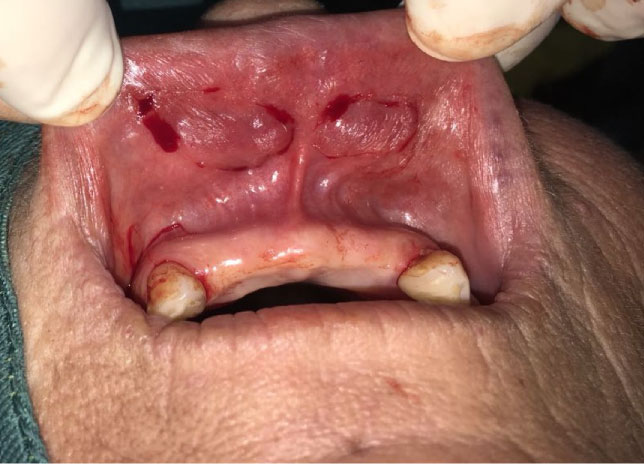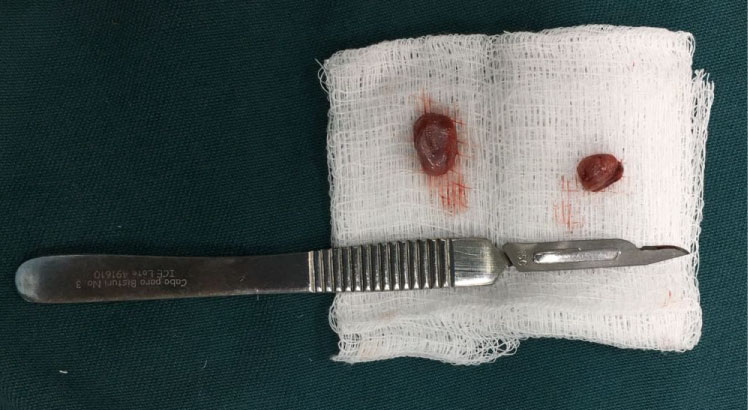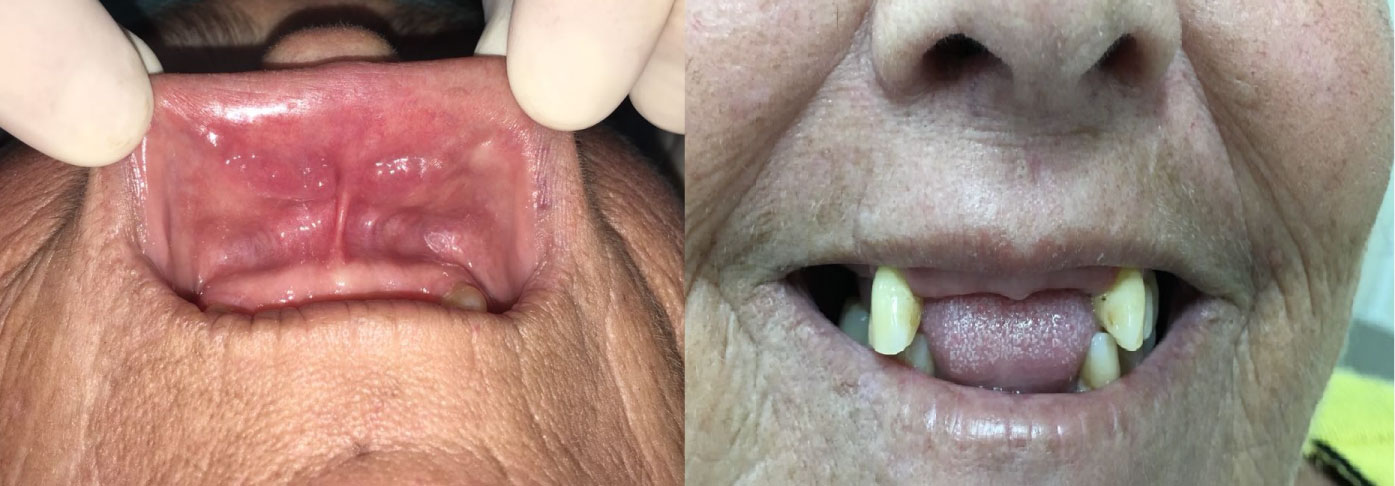The double lip is a rare and benign developmental alteration characterized by increased lip tissue, specially of the upper lip. Its etiology is linked to congenital factors, such as Ascher Syndrome, or being acquired by labial trauma. The main related complaint is the aesthetic, and the diagnosis is predominantly based on the clinical aspect. The hormonal exams are part of the differential diagnosis. Regarding the treatment, there are several techniques of surgical excision but the elliptical incision, also known as wedge, has presented better results and low rate of postoperative sequelae. The objective of this study is to report a bilateral double-lip clinical case, correlating it with what is current in the literature. Patient M.J.S.S., female, leukoderma, 55-years-old, attended the Center for Dental Specialties (CDS) of ASCES-UNITA due to the presence of an upper lip lesion; the patient reported aesthetic complaint and during the physical examination a bilateral alteration in the upper lip was observed, which was expressed when she smiled with double-lip characteristics, in addition to dental absence of all anterior and superior dental elements. After the diagnostic hypothesis, the surgical treatment chosen was total excision of the excess tissue with incision in ellipse and referral of the specimen for histopathological examination. After 7 days the synthesis material was removed with signs of good healing. Patient had follow-up for 3 months without signs of relapse. It is concluded that the double lip is rare affection lesion, which practically has a clinical diagnosis, and shows several forms of surgical treatment that should only be performed through aesthetic and/or functional complaint of the patient. Correct diagnosis is essential for the elimination of Ascher syndrome, thus leading to the best possible treatment.
Oral surgery, Lip, Maxillofacial anomalies
The double lip is a benign oral alteration characterized by excess of hyperplastic tissue in the lips, and in most cases affects the upper lip, being unilateral or bilateral [1,2]. It is characterized by a hypertrophy of the minor salivary glands associated with the increase of the labial mucosa that does not affect the surrounding muscles [3].
Its etiology may be associated with congenital or acquired factors [4]. Congenital ones are related to lip developmental disorders, or to patients with Ascher Syndrome, which is characterized by the triad: Double lip, blepharochalasis, and non-toxic enlargement of the thyroid gland; whereas acquired factors involve continuous and persistent lip traumas as in poorly adapted prostheses or lip suction acts [5-7].
Its incidence is rare, affecting on average 02 out of 1,000 individuals and there is no predilection for age or gender [8]. Clinically, it is shown as an increase in volume on the inner side of the lip more prominently in the lateral resting area. It becomes more apparent in the movements of smiling or speaking due to the tension applied to the lips, which can result in aesthetic and/or functional damage [9,10].
Surgical treatment for double-lip patients should be considered when there is aesthetic and/or functional impairment and is usually surgical excision [11]. Alternative techniques such as W labioplasty, triangular incisions and helical labioplasty are described in the literature, all with the purpose of removing excess tissue [12,13]. The labial stretch surgery offers challenges mainly due to the asymmetry and volume of the lip's red cutaneous line, which should be perfectly aligned for a better aesthetic result; however, in cases of double lip cheiloplasty, this is not a problem, since in the great majority it is confined to the internal side of the lip, in the mucous region. In these cases, the professional should be aware during the procedure to not cause injury to the inferior labial artery that crosses the region [14].
This study aims to report a clinical case of double upper bilateral lip, discussing its diagnosis and treatment, correlating it with the data present in the literature.
Patient M.J.S.S., female, leukoderma, 55 years of age attended the stomatology CDS of ASCES-UNITA Caruaru/PE-Brazil for evaluation of an "upper lip injury". During the anamnesis, the patient reported presence of "lumpiness" on the upper lip with approximately 2 years of evolution, with an aesthetic complaint and no painful symptoms, but she complained that she bit her lip when she was going to speak due to the absence of the upper anterior teeth. She was hypertensive and had medicament-controlled Blood Pressure (BP).
The facial examination revealed that when the patient was resting, the upper lips did not display any changes, but when the patient was smiling two elevations were noticeable, one on each side of the lip, with normal mucosa color and sessile base with approximately 2.0/0.5 cm in length with suggestive features of double lip (Figure 1). At the oral physical examination, partial edentulism was observed, without the presence of the upper anterior dental elements. After evaluation, it was decided to perform cheiloplasty, mainly due to the referred aesthetic complaint. The procedure was performed under conscious sedation with a 15 mg midazolam pill, administered 30 minutes before the procedure to reduce the great anxiety and consequent increase in BP, which was 160 × 90 mm Hg. Then, antisepsis of the entire operating field was performed, as well as local anesthesia by bilateral infra orbital nerve block with 2% mepivacaine with 1: 100,000 epinephrine. Afterwards, the incisions were demarcated with the aid of the back of the scalpel blade, elliptically around the excess labial tissue (Figure 2), as well as exertion of the incisions together with associated accessory salivary glands, to avoid future development of mucocele (Figure 3). The suture was performed with 4-0 silk thread in single stitches (Figure 4). The surgical specimen was submitted to histopathological examination with a diagnostic hypothesis for double lip (Figure 5). After 7 days suture removal was performed, without phlogistic signs and good healing. The patient has been under follow-up for 3 months without signs of recurrence (Figure 6).
 Figure 1: Aspect of the lips alteration during the smile.
View Figure 1
Figure 1: Aspect of the lips alteration during the smile.
View Figure 1
 Figure 2: Demarcation of the incision performed with the back of the scalpel.
View Figure 2
Figure 2: Demarcation of the incision performed with the back of the scalpel.
View Figure 2
 Figure 3: Exertion of the lesion of associated accessory glands.
View Figure 3
Figure 3: Exertion of the lesion of associated accessory glands.
View Figure 3
 Figure 4: Suture with 4-0 silk thread in single stitches.
View Figure 4
Figure 4: Suture with 4-0 silk thread in single stitches.
View Figure 4
 Figure 5: Surgical specimen.
View Figure 5
Figure 5: Surgical specimen.
View Figure 5
 Figure 6: a) View of the internal labial mucosa, 3 months postoperative; b) Smile appearance, 3 months postoperative.
View Figure 6
Figure 6: a) View of the internal labial mucosa, 3 months postoperative; b) Smile appearance, 3 months postoperative.
View Figure 6
The double lip is a pathology characterized by an increase in non-neoplastic volume, which in most cases affects the upper lip. Besides that, it can be bilateral, when there is distension of the lips [1,3]. The current case presented the characteristics mentioned above, in addition to bilateral accompaniment, which is a common manifestation of this alteration.
Studies show a certain divergence in relation to the affection between genders [15-17], in which some state that there is no predilection for gender, while others suggest that the double lip has male predilection in the proportion of 7:1 [18]. If this is the case, the current report is a rare affection, since the patient is female.
In relation to the predisposing factors for the appearance of these benign lesions, they may be related to congenital factors such as an Ascher syndrome, as well as acquired factors, as reported in this case in which the patient informed that she bit her lips and had difficulty while speaking since she had no upper anterior teeth [19,20].
In relation to the hypothesis of Ascher syndrome which is represented by the triad double lip, blepharochalasis and non-toxic thyroid alterations, it was ruled out in the mentioned case once, through the visual method, no alterations were observed in the eyelids referring to blepharocalasis, as well as no absence of hormonal changes [5-7].
Surgical treatment should be indicated in cases of aesthetic or functional deficit, as in the case in which the patient reported aesthetic complaints that "significantly disturbed her during the smile". In the immediate postoperative period, it was possible to verify the patient's satisfaction by looking in the mirror and noting a more harmonious smile [11,12,21]. The literature describes several excision techniques such as wedge excision, zetaplasty and others, which, regardless of the technique, should remove only the excess lip to avoid sequelae related to lip asymmetry [22].
The surgical technique used was that of excision in bilateral ellipsis [13], which is the most used technique due to the ease of execution and to the fact that it is linked to the lower rates of postoperative sequelae.
It is concluded that the double lip is a rare lesion, little documented in the literature, which signs and symptoms are enough to carry out an accurate diagnosis. Hormonal changes and atypical increases of the thyroid and palpebral changes must be verified to perform differential diagnosis of double lip, or presence of Ascher Syndrome. Like several surgical procedures in dentistry, the cheiloplasty for dual lip removal interferes positively in the patient's daily life, since it allows them not only the functionality back but also the mere pleasure of smiling. This case report, as well as others described in the literature, are of fundamental importance in supplying information regarding these alterations. They update the professionals about main features so that there is a correct diagnosis and treatment besides the functional aesthetic reestablishment of patients, especially nowadays, when there is a strong aesthetic demand by the society.